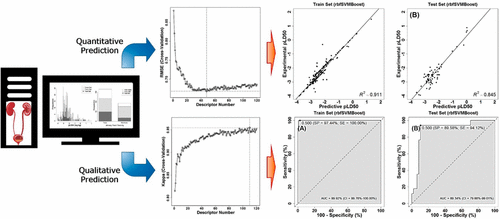当前位置:
X-MOL 学术
›
Mol. Pharmaceutics
›
论文详情
Our official English website, www.x-mol.net, welcomes your
feedback! (Note: you will need to create a separate account there.)
ADMET Evaluation in Drug Discovery. 18. Reliable Prediction of Chemical-Induced Urinary Tract Toxicity by Boosting Machine Learning Approaches
Molecular Pharmaceutics ( IF 4.5 ) Pub Date : 2017-10-27 00:00:00 , DOI: 10.1021/acs.molpharmaceut.7b00631 Tailong Lei 1 , Huiyong Sun 1 , Yu Kang 1 , Feng Zhu 1 , Hui Liu 1 , Wenfang Zhou 1 , Zhe Wang 1 , Dan Li 1 , Youyong Li 2 , Tingjun Hou 1, 3
Molecular Pharmaceutics ( IF 4.5 ) Pub Date : 2017-10-27 00:00:00 , DOI: 10.1021/acs.molpharmaceut.7b00631 Tailong Lei 1 , Huiyong Sun 1 , Yu Kang 1 , Feng Zhu 1 , Hui Liu 1 , Wenfang Zhou 1 , Zhe Wang 1 , Dan Li 1 , Youyong Li 2 , Tingjun Hou 1, 3
Affiliation

|
Xenobiotic chemicals and their metabolites are mainly excreted out of our bodies by the urinary tract through the urine. Chemical-induced urinary tract toxicity is one of the main reasons that cause failure during drug development, and it is a common adverse event for medications, natural supplements, and environmental chemicals. Despite its importance, there are only a few in silico models for assessing urinary tract toxicity for a large number of compounds with diverse chemical structures. Here, we developed a series of qualitative and quantitative structure–activity relationship (QSAR) models for predicting urinary tract toxicity. In our study, the recursive feature elimination method incorporated with random forests (RFE-RF) was used for dimension reduction, and then eight machine learning approaches were used for QSAR modeling, i.e., relevance vector machine (RVM), support vector machine (SVM), regularized random forest (RRF), C5.0 trees, eXtreme gradient boosting (XGBoost), AdaBoost.M1, SVM boosting (SVMBoost), and RVM boosting (RVMBoost). For building classification models, the synthetic minority oversampling technique was used to handle the imbalance data set problem. Among all the machine learning approaches, SVMBoost based on the RBF kernel achieves both the best quantitative (qext2 = 0.845) and qualitative predictions for the test set (MCC of 0.787, AUC of 0.893, sensitivity of 89.6%, specificity of 94.1%, and global accuracy of 90.8%). The application domains were then analyzed, and all of the tested chemicals fall within the application domain coverage. We also examined the structure features of the chemicals with large prediction errors. In brief, both the regression and classification models developed by the SVMBoost approach have reliable prediction capability for assessing chemical-induced urinary tract toxicity.
中文翻译:

药物发现中的ADMET评估。18.通过促进机器学习方法可靠地预测化学诱导的尿路毒性
异种生物化学物质及其代谢产物主要通过尿路经尿道排出体外。化学诱导的尿路毒性是在药物开发过程中导致失败的主要原因之一,并且它是药物,天然补品和环境化学品的常见不良事件。尽管它很重要,但只有很少的计算机评估具有多种不同化学结构的化合物的尿道毒性的模型。在这里,我们开发了一系列定性和定量的构效关系(QSAR)模型来预测尿路毒性。在我们的研究中,将与随机森林结合的递归特征消除方法(RFE-RF)用于降维,然后将八种机器学习方法用于QSAR建模,即相关向量机(RVM),支持向量机(SVM) ),正规化随机森林(RRF),C5.0树,极限梯度增强(XGBoost),AdaBoost.M1,SVM增强(SVMBoost)和RVM增强(RVMBoost)。对于建筑物分类模型,使用合成少数样本过采样技术来处理不平衡数据集问题。在所有机器学习方法中,q ext 2 = 0.845)和测试集的定性预测(MCC为0.787,AUC为0.893,敏感性为89.6%,特异性为94.1%,整体准确度为90.8%)。然后分析了应用领域,所有测试过的化学药品都在应用领域范围内。我们还检查了具有较大预测误差的化学品的结构特征。简而言之,通过SVMBoost方法开发的回归模型和分类模型均具有可靠的预测能力,可用于评估化学诱导的尿路毒性。
更新日期:2017-10-27
中文翻译:

药物发现中的ADMET评估。18.通过促进机器学习方法可靠地预测化学诱导的尿路毒性
异种生物化学物质及其代谢产物主要通过尿路经尿道排出体外。化学诱导的尿路毒性是在药物开发过程中导致失败的主要原因之一,并且它是药物,天然补品和环境化学品的常见不良事件。尽管它很重要,但只有很少的计算机评估具有多种不同化学结构的化合物的尿道毒性的模型。在这里,我们开发了一系列定性和定量的构效关系(QSAR)模型来预测尿路毒性。在我们的研究中,将与随机森林结合的递归特征消除方法(RFE-RF)用于降维,然后将八种机器学习方法用于QSAR建模,即相关向量机(RVM),支持向量机(SVM) ),正规化随机森林(RRF),C5.0树,极限梯度增强(XGBoost),AdaBoost.M1,SVM增强(SVMBoost)和RVM增强(RVMBoost)。对于建筑物分类模型,使用合成少数样本过采样技术来处理不平衡数据集问题。在所有机器学习方法中,q ext 2 = 0.845)和测试集的定性预测(MCC为0.787,AUC为0.893,敏感性为89.6%,特异性为94.1%,整体准确度为90.8%)。然后分析了应用领域,所有测试过的化学药品都在应用领域范围内。我们还检查了具有较大预测误差的化学品的结构特征。简而言之,通过SVMBoost方法开发的回归模型和分类模型均具有可靠的预测能力,可用于评估化学诱导的尿路毒性。











































 京公网安备 11010802027423号
京公网安备 11010802027423号